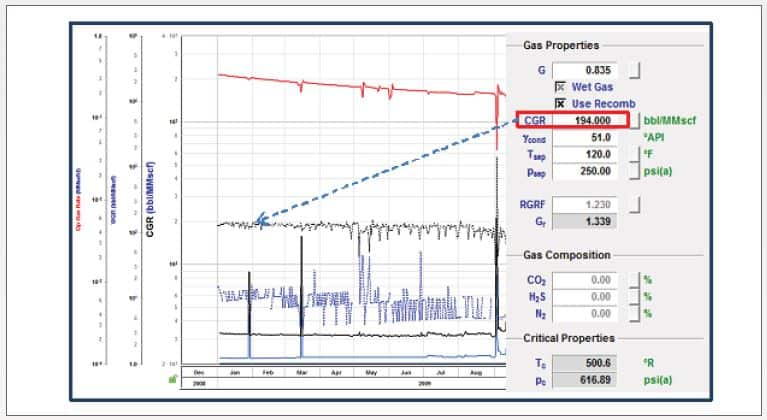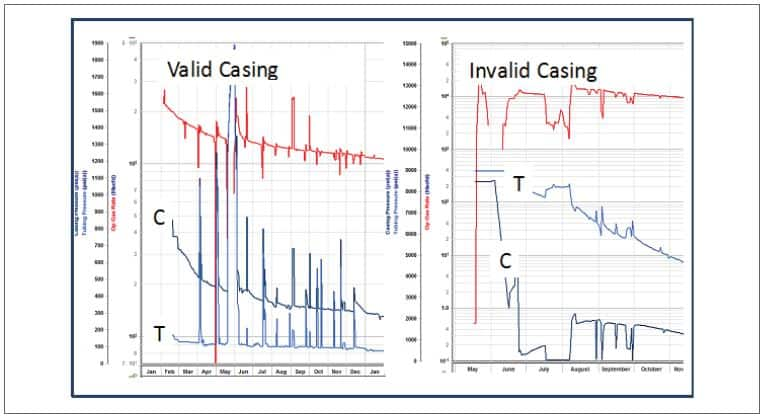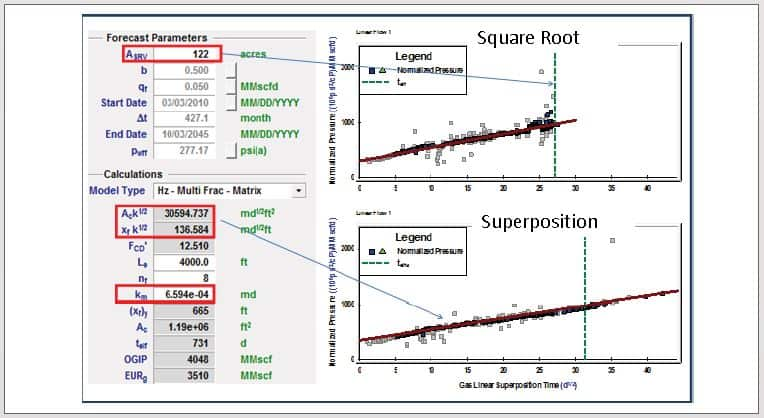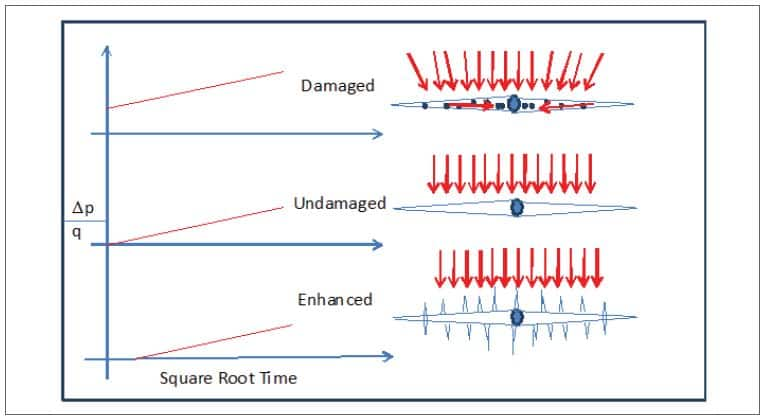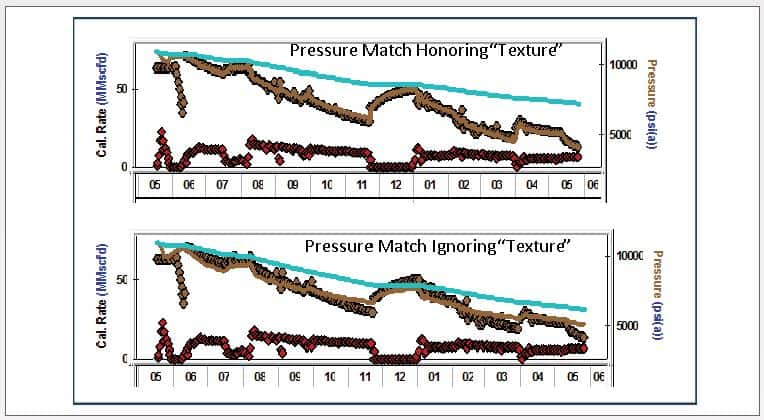Practical pointers and rules of thumb for RTA of unconventional plays
Reservoir and PVT Properties
Reservoir Pressure - Let’s start with the basic measurements required for every well evaluation. The most important of these is reservoir pressure. In unconventional plays, this is particularly difficult to obtain because the low permeability of the rock inhibits achieving a stabilized pressure on a buildup test. A practical alternative is to conduct a pre-completion DFIT (diagnostic fracture injection test), which will provide a reliable reservoir pressure for very little time and cost. In the absence of a measured initial pressure, using a pore pressure gradient from an analog well is acceptable, provided the analog is from a similar depth and depositional environment.
PVT(Pressure-Volume-Temperature) - PVT data is critical for reliable RTA. In dry shale gas plays, a basic laboratory gas analysis, yielding gas gravity and impurities is sufficient. However in rich gas condensate and oil plays, it is important to obtain a more detailed laboratory PVT analysis. Reliable downhole samples are difficult and expensive to collect in deep, low perm environments and therefore most lab work is done using surface samples. When entering PVT data from a laboratory analysis, pay particular attention to the recombined liquid-gas ratio used in the analysis. Ensure that this ratio is reasonably consistent with the observed production data. In gas-condensate systems, RTA requires the stock tank gravity of the condensate and the separator temperature and pressure. The liquids produced at surface should be mathematically recombined with the produced gas using a CGR based on the average of the first 1-3 months. In oil systems, the stock tank gravity and bubble point pressure are required. If reliable PVT data is available, it should be entered directly as custom tables. If not, the standard oil correlations can be used to predict oil properties such as formation volume factor, solution GOR and viscosity.
Geomechanics - In overpressured unconventional plays, geomechanical effects may be important to well performance; specifically in cases where the pore pressure gradient exceeds 0.75 psi/ft. In these wells, set initial formation compressibility to a minimum of 10 microcips (higher than what the Hall correlation predicts), and set the “gamma” factor, which controls how permeability and formation compressibility change with pressure, to a minimum of 1e-5. The value of gamma to be used in a specific well analysis will often be determined based on the model history match.
Wellbore Considerations
Tubing versus Annular Pressures - Availability of surface measured rates/pressures is widespread in unconventional plays. To perform reliable RTA, pressures must be converted to sandface conditions. In tubingless completions, it is important to look out for subcritical gas velocity, which will make the pressure loss calculations much less reliable. If tubing exists without a packer in place, as is often the case in shale plays such as the Marcellus, use annular (quiet side) pressures as the source, if possible. In deeper plays, this may not be possible. A simple plot of annular (casing) and tubing pressure versus time will indicate whether or not the annular pressure is in hydraulic communication with the sandface.
Supercharge Effect - Due to the high volume of frac fluids injected and low rock permeability, the early production period (may be several months) may yield calculated sandface pressures that are “supercharged” (abnormally high). Since RTA does not address the complex physics of this flow period, it is best to ignore or apply a simple correction to this data. One option is to simply remove the produced liquid rates during the early time. In the event that initial pressure is estimated and not measured, it may be best (and easiest) to shift it upwards to be consistent with the BHP data.
Artifical Lift - Some unconventional plays use gas lift or downhole pumps to reduce wellbore pressure loss. In gas lift applications, the produced and injected gas volumes must be tracked separately in order to obtain a reliable analysis. In performing BHP calculations, the total (produced + injected) gas volumes should be used to calculate the pressure loss through the tubing, whereas only the produced gas volumes should be used in the actual rate transient plots and models. Wells equipped with rod pumps require continuous measurement of annular (casing) pressure and frequent measurement of annular liquid level (monthly is acceptable, but daily is better).
Analyzing and Forecasting Unconventional Well Performance
Superposition or Square Root? - Now we’re into the analysis of the sandface data. Specialized linear flow analysis (consisting of normalized pressure plotted against a time function) has been observed to be one of the simplest and best methods of identifying linear flow and extracting key well performance parameters. But which time function should we use? Using linear superposition time on the x-axis yields a more accurate estimate of Asqrt(k) (slope) and FCD’ (y-intercept), than does a similar plot with square root time on the x-axis. However, the square root time plot has less bias, and is therefore better for initial flow regime identification. It is also simpler to identify the minimum HCPV, based on time-to-end of transient flow, using the Square root time plot. To maximize analysis value, both plots should be used.
Positive and Negative Intercepts - When generating specialized linear flow plots, we have observed a wide variety of y-intercept behavior. Some plots exhibit y-intercepts very near the origin, while some are significantly positive or negative. It is tempting to attribute intercept behavior directly to some sort of reservoir response. However, the analyst should first rule out simple data issues. For example, if the “supercharge” effect (previously introduced) is present in the data, a negative intercept will often be exhibited. Once data quality has been validated, the specialized plot intercept can be attributed to the “condition” of fractures in the reservoir. A zero intercept is indicative of linear flow from matrix into an infinitely conductive fracture (or connected fracture network). A positive intercept indicates some kind of apparent skin that inhibits the full productivity of the fracture system. It may be inclusive of low fracture conductivity, fracture face skin, convergence, non-darcy flow, and/or proppant embedment, among others. In contrast, a negative intercept suggests that the fracture has been enhanced, and not damaged. One explanation of this is a planar fracture with “hair” or small branches that extend orthogonally to the primary fracture plane, created through shear failure of the rock during leak-off in hydraulic fracturing.
Modeling and Automatic Parameter Estimation - Models provide a validation of your interpretation and a basis from which to forecast production and predict ultimate recovery. When choosing a model, pick the simplest model that is able to accurately history match the measured data while maintaining basic “believability” in its geometry and reservoir characteristics. The analytical Horizontal Multi-frac Uniform model is suitable in a wide variety of cases. To obtain the best possible history match, use Automatic Parameter Estimation, but on as few simultaneous parameters as possible. The trick is figuring out which parameters must remain anchored in order to obtain a unique result. Since “xfsqrt(k)” is usually a known value from well performance, it is not a good idea to apply APE on both xf and k simultaneously. Repeatable, consistent results can be obtained by anchoring xf, based on the minimum contacted HCPV and applying APE to k and FCD to obtain the optimum solution.
History Matching to the “Texture” of the Data - When history matching with models, pay close attention to operational changes such as choke changes and well shut-ins, especially if the data is of good quality. These events can often be matched better by adjusting geomechanical parameters or invoking time dependent skin. In the Haynesville, for example, these events have provided “texture” to the history match, releasing information that would not have otherwise been available from simpler diagnostic plots.
Final Thoughts
Obtaining reliable results from RTA is difficult and requires skill and experience. The rules of thumb provided here are not a replacement for that skill and experience, but they can point you in the right direction and save you time when evaluating your unconventional well performance data. IHS offers technical and practical, hands-on workshops for RTA of unconventional plays using our IHS Harmony™, IHS RTA and IHS DeclinePlus software.
Dave Anderson, Fekete Associates Inc.
Posted 5 November 2015
This article was published by S&P Global Commodity Insights and not by S&P Global Ratings, which is a separately managed division of S&P Global.
